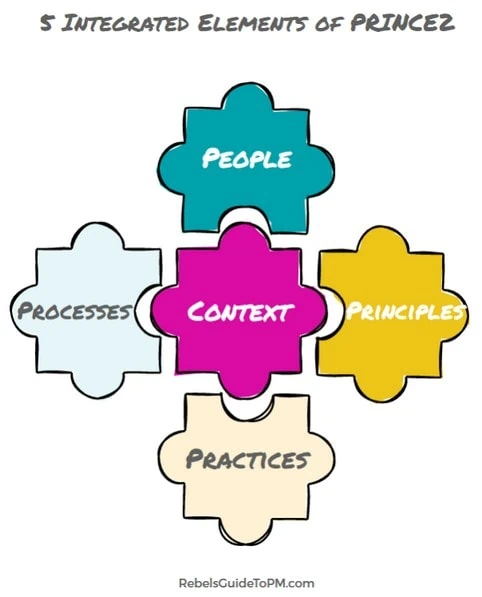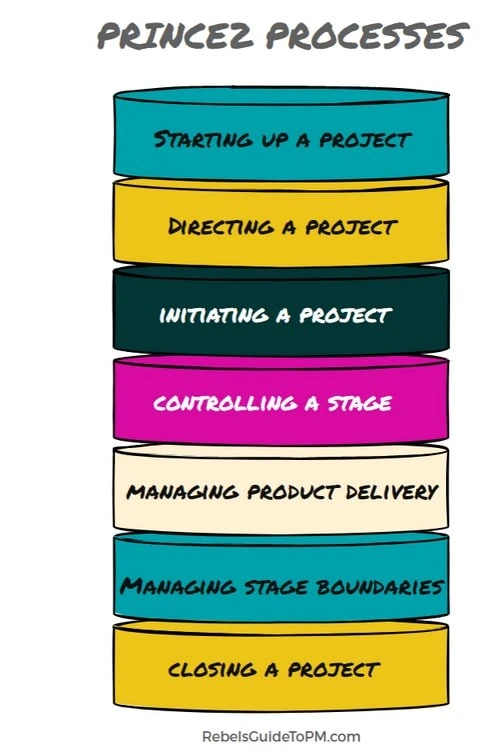PRINCE2: The project management method explained
This blog is reader-supported. When you purchase something through an affiliate link on this site, I may earn some coffee money. Thanks! Learn more.
What is PRINCE2®?
PRINCE2® is a project management method. It’s structured, and experience-based, created from the lived experience of thousands of project managers and successful projects.
PRINCE2® stands for Projects IN a Controlled Environment (Version 2). And it’s not spelled PRINCE TWO!
It’s a customizable way of managing and controlling the work. It’s tailorable and suitable for projects of all sizes, large and small.
I took my first Practitioner course in 2004.

Who is PRINCE2® for?
PRINCE2® works in a huge number of industries and domains. As a project manager, I have used it in financial services, and to a lesser degree, a modified version in a healthcare setting. It’s a predictive methodology, although PRINCE2
Because PRINCE2® is a broad-brush approach, it doesn’t cover technical processes or specific techniques, but it will fit alongside them.
The history of PRINCE2®
PRINCE2® is part of the best practice guidance that came out of the UK Office of Government Commerce.
It started life as the PROMPT methodology, created in a private UK company back in the 1970s. A British government agency, the Central Computer and Telecommunications Agency, licensed it for use in government IT projects back in 1979.
It was renamed PRINCE.
PRINCE2® was released in 1996 and had major updates in 2009 and 2017. The most recent major update came in 2023.
I was asked to be one of the reviewers of the PRINCE2 7 manual, so I am very familiar with the content and changes since the last edition.
The PRINCE2 method is something that was used mainly in public sector UK projects, but quickly got picked up by the private sector and spread throughout Europe and the rest of the world. Because it works. Today, it is used by thousands of practitioners in hundreds of countries.
PRINCE2
The 5 elements of PRINCE2
There are 5 integrated elements of PRINCE2. These are:
- People (new for the 7th edition, there is a whole new chapter which is long overdue in my view)
- Principles
- Processes
- Practices (this section used to be called Themes, if you are familiar with the 6th edition)
- Project context (which is where we talk about the business environment and tailoring).

PRINCE2 core principles
The 7 core principles in PRINCE2® project management are the ‘guiding obligations’ to ensure that critical areas for success are constantly front of mind. They are:
- Ensure continued business justification
- Learn from experience
- Define roles, responsibilities and relationships
- Manage by exception
- Manage by stages
- Focus on products
- Tailor to suit the project.
Let’s have a quick look at these best practices.
1. Ensure continued business justification
A PRINCE2® project needs a business case. There should be a point to doing any new project: there should be some business driver to doing the work.
And that business justification needs to last throughout the project. You should keep checking in, for example at the end of each stage of the project, to make sure that the work is still viable.
Ideally, you’ll be able to achieve the benefits but sometimes things happen to make that difficult. In those cases, you might want to recommend the project is stopped.
2. Learn from experience
There is a focus in PRINCE2® on learning from experience. You should look at what happened on past projects because that helps mitigate risk on your current project.
Lessons learned isn’t something you do once. PRINCE2® encourages you to dig into lessons learned all through the project life cycle to help you make better choices. Document lessons learned for future projects.
3. Define roles, responsibilities and relationships
There are defined roles and responsibilities in PRINCE2® projects. There are 3 main stakeholders:
- Sponsor: the business sponsor who make sure the project delivers the right thing
- Users: people who use the end result and/or receive the benefit
- Suppliers: people or companies that provide the resources to get the project done.
The default roles are:
- The project board, made up of the executive (sponsor), senior user (user rep) and senior supplier (supplier rep)
- Project manager
- Project support
- Project assurance
- Change authority
- Team manager.
That’s it. All the team members fit into one of those roles, although it is possible to tailor the structure to suit your environment.
The relationships part of this principle’s title is all about the project ecosystem and how soft power and networks influence the way work gets done.
4. Manage by exception
I love this principle. It means you have boundaries and tolerances set for your role as the PRINCE2® project manager, and you can operate within those boundaries. If you go out of those, there is an exception, and you escalate or get management input as necessary.
Management by exception works at every level and relies on the project team being trusted to do their job. When that happens, the sponsor and project board only need a regular report at the prescribed times.
This avoids micromanaging and builds trust in the team.
5. Manage by stages
PRINCE2® delivers the work in stages. The project manager and team break down the work into chunks called management stages.
There’s a process to guide work through the stages so there is adequate control at every point.
At the end of a stage, the project board decides whether the project is still viable and whether it should move on.
6. Focus on products
The method has a focus on products, which means you create a product description so that everyone knows what the project is creating. It’s a way to ensure expectations are managed and all stakeholders are on the same page.
Products can be defined in work packages. There’s normally some documentation that lists out what the products are so everyone understands what is being delivered.
7. Tailor to suit the project
The final principle is that PRINCE2® should be tailored to the environment. You can tailor to fit the project’s:
- Size
- Importance
- Environment
- Team culture
- Risk
- Complexity.
Tweak project controls to make the whole thing work for your situation.
What’s missing from PRINCE2® (thankfully) is the detailed guidance on ‘how’. For example, it talks about creating a schedule, but doesn’t mandate how to do that. You can use critical path scheduling, a Gantt chart, full on earned value management for schedule control, or some sticky notes on the wall. PRINCE2® won’t beat you up for choosing the right scheduling approach for your environment.
PRINCE2® practices
There are 7 practices in PRINCE2®. Let’s look at these.
1. Business case
The business case shows up in the principles as well – that’s how it important it is. It’s probably the most important one of the management products (that’s my view anyway: in the manual, they all have the same importance).
The business case ensures that the project is worthwhile and aligns to business goals. It also links back to performance targets. There is a new performance target of sustainability in the 2023 7th edition, which requires having a sustainability management approach in place for the project.
Finally, the business case empowers the project manager to recommend the project is stopped if the business benefits won’t be realized.
2. Organizing
This relates to the project organization: roles and responsibilities, the team, and the management set up for the project.
It’s the practice that enables the project leadership, effective communication, and team empowerment. It also covers organizational design and development.
3. Plans
PRINCE2® guides you towards creating plans that answer the questions stakeholders want to know: What are we doing?
- How are we doing it?
- How much will it cost?
- When will it be ready?
The plans involved in PRINCE2® are:
- The project plan
- The stage plan
- The exception plan
- The team plan.
4. Quality
PRINCE2® talks a lot about quality. It sets out how to define product quality, how to measure it and the process for controlling it. This section also covers the idea of having a product register to track what is being created.
When I did my PRINCE2® course, this section was really valuable because quality is theoretically understood, but not always acted on at work. This practice helped me understand how to create a quality focus that wasn’t all about simply writing a quality plan.
5. Risk
Risk management is a core practice across many project management methods, and PRINCE2® gives you a practical approach to putting it front and center.
PRINCE2® fits in with the Management of Risk® guidance, also from Axelos. The risk method draws on that so the whole family of methods work together. It provides an approach to do risk assessment and then plan management actions to ensure the risk is adequately addressed. You’ll record your risks is a risk log.
6. Issues
This used to be the theme of Change, but PRINCE2 uses the terminology of ‘issue’ to mean anything that affects the project, and that could be a problem (i.e. an issue), an ‘off-specification’ defect or a change. Often issues lead to changes anyway and there is a similar process of analyzing and decision-making that we follow for both.
That said,
There’s a whole process to follow that allows changes to be proposed, analyzed and acted on as necessary. And of course we have to push issues through a process that allows the project team to address them as well.
7. Progress
What’s the point of a project if not to make progress towards delivering the solution? You manage the project’s progress actively to ensure everything goes to plan.
The progress practice helps you control the project. This practice talks about having decent project reporting, tracking and monitoring performance, tolerances, issues, changes and risks, knowing when to escalate and being able to deal with deviations.
PRINCE2® processes
People tend to think of PRINCE2® as quite a process-heavy method, and when I first did my exam, I felt the same. However, there is a lot of emphasis on tailoring, and the latest version is very flexible.
The processes are really not that complicated to understand or to do, and they are simply about having enough governance to make sure the project is properly under control. You will find them very intuitive once you get going and understand the
The core processes in PRINCE2® cover the whole life cycle and are:
- Starting up a project
- Directing a project
- Initiating a project
- Controlling a stage
- Managing product delivery
- Managing a stage boundary
- Closing a project.

Starting up a project
This process looks at whether the project is worthwhile and viable. The project brief gets created and the project board decide whether to go ahead.
Directing a project
Directing a project had a whole separate PRINCE2® book in the 6th edition, and I wonder whether there will be a new guide for project sponsors released in due course. Directing gets a process of its own. It’s the process that the sponsor and project board go through to make decisions and provide that governance layer.
It’s the activities that provide the parallel management and steering level that run alongside the work the project manager is leading.
Initiating a project
Once the project passes through the Start up phase, you move into initiating. This is where you dig into the work that needs to be done and you start planning.
There’s quite a lot of documentation that PRINCE2® suggests you create during this stage because the plan is created and you decide how to do risk management, communications, project controls, change control, quality and more.
Controlling a stage
This process helps you monitor and control the work throughout the stage. It’s the day-to-day effective project management that falls into this process.
You review progress, monitor that against the baseline you set and correct any deviations.
Managing product delivery
This process is what you use when you are ready to complete a product delivery. As you can imagine, these processes often overlap and happen in parallel, so PRINCE2® doesn’t exactly offer you a start-to-finish step-by-step approach. It’s far more flexible than that.
You might use this process several times throughout the life cycle as you need to get stakeholders to accept products as you go.
Managing a stage boundary
Stage boundaries are the points at which you move the project on. This is the process you use moving between project stages. It’s basically the approval for moving on to the next chunk of the work.
The project board review progress so far, look at the business justification and make the call as to whether the work continues.
Closing a project
Finally, there is a process around closing a project. It covers how to wrap up the work and ensure the loose ends are tidied away, making sure the products are delivered to the required standard and handed over effectively to the users.
It covers verification of the product, making sure the required support is in place and ensuring open actions and issues are addressed. You’ll also review the project’s performance and assess the benefits.
Becoming PRINCE2® certified
There are two levels of PRINCE2® certification: Foundation and Practitioner.
There is the ‘ordinary’ flavor of PRINCE2® and then there is also
You’ll need to choose a training course and study with an accredited provider. I recommend studying with a PRINCE2® exam simulator because taking practice questions are key to not flaking out in the exam. I did loads of past papers when I took it, and they really helped. Once you re ready, take the exam(s).
Typically, the full Foundation/Practitioner certification course is 5 days, including both exams. There are no prerequisites for enrolling for the Foundation course. You can also take the course online with plenty of different format options.
However, I would say that some project management experience will make it easier for you to do the training and get through the exam, because it is intensive.
The course I took (and the format most in-person courses take) is to do the knowledge-led content over 2.5 days and then take the Foundation certificate exam on the Wednesday afternoon. Then spend Thursday and Friday morning on Practitioner content and exam prep, with the Practitioner exam on the Friday afternoon.
In other words, you can get PRINCE2® certified in a week with no prerequisites, which makes it a good option for people who don’t have years of experience.
You will need to maintain your certificate with a subscription service or take the exam again when it expires.
Ready to get certified? Check out the AXELOS-accredited PRINCE2® Practitioner course led by Frank Turley offered by Management Plaza.
A comprehensive and accredited PRINCE2® Practitioner online course, including exam voucher and simulator access.
Summary
PRINCE2® is one of the project management methodologies open to you. It’s a flexible, effective method for leading an entire project. Where will PRINCE2® take you?
More PRINCE2® Resources
- PRINCE2: The project management method explained
- How to choose a PRINCE2 course online
- The Best PRINCE2 exam simulators
- MPlaza PRINCE2® Practitioner exam simulator review
- MPlaza PRINCE® Foundation exam simulator review
- PRINCE2® and PMBOK®: How they compare
- 7 Best PRINCE2 books (Including PRINCE2 Agile books)
- What PRINCE2 certification should you get?
- The Best PRINCE2 course for beginners
- 12 Tips for PRINCE2 Practitioner exam success

